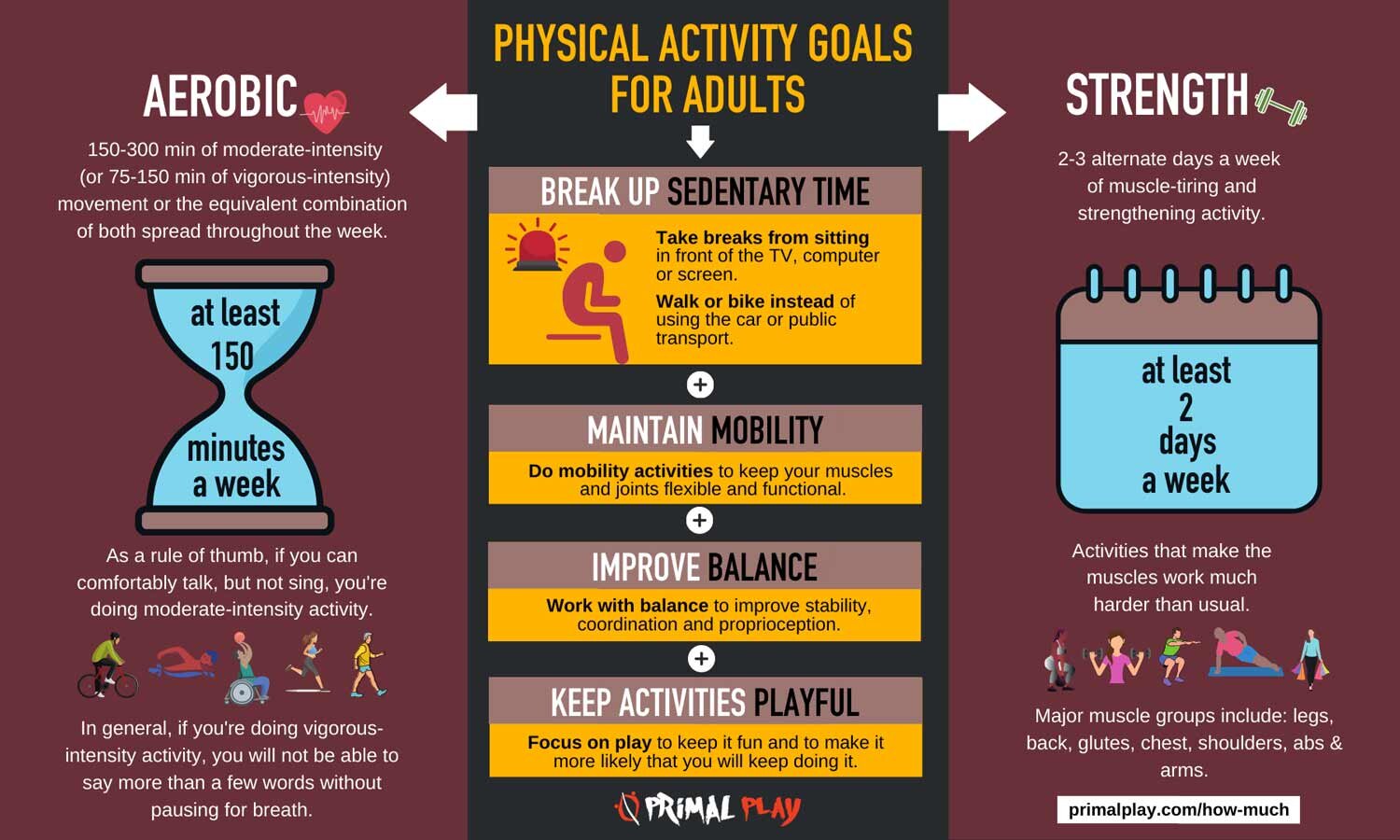TODAY IS THE DAY TO QUIT A SEDENTARY LIFESTYLE
WANT TO QUIT SEDENTARY?
Are you struggling to find time to exercise, or are you sitting at a desk for most of the day?
A sedentary lifestyle is when you regularly participate in little or no physical activity for the majority of the day.
Do you want to break out of a sedentary lifestyle? Do you want to reduce or stop sedentary behaviours?
Quitting a sedentary lifestyle takes an intentional effort, but it is one of the best things you can ever do for your health [1],[2].
Movement is beneficial for your physical [3], mental [4],[5] and emotional health [6]. Moving more with an active lifestyle can enhance your mood, reduce stress, anxiety and depression—especially when the activities chosen are engaging and fun.
We should aim to be active every day. Some movement is good—more is even better. Everyone can experience the health benefits of physical activity, regardless of age, skill, ability or disability.
If you have haven't been active for a while, start slowly. If you feel unsure about what to do, speak to a qualified health professional about which activities are best for you.
Make a start today; it's never too late to fix a sedentary lifestyle.
“A sedentary lifestyle is when you regularly participate in little or no physical activity for the majority of the day. ”
JUST A FEW REASONS TO MOVE MORE
Let’s kick the sedentary habit
Being active is good for your mind and body. It can reduce your risk of chronic (long-term) conditions, such as heart disease, type 2 diabetes, high blood pressure, dementia, stroke, cancer, and lower the risk of early death by up to 50% [7].
Physical activity can also:
improve your sleep
improve your mental health and mood
increase your chances of living longer
improve body composition
reduce the risk of falls
boost energy levels
aid self-esteem
help keep your thinking and learning skills sharp as you age
strengthen your bones and muscles
help to maintain physical function and independence as you age
There are many reasons to reduce sedentary behaviours one of them is based on the fact that it is difficult to exercise away the harmful effects of too much sitting time. [7a]
SEDENTARY LIFE IS A NOTABLE 21ST CENTURY PROBLEM
People are less active nowadays, mainly because technology and labour-saving devices have made our lives easier. But this convenience comes at a cost. We are spending more time in a chair than ever before with a negative consequence to our health.
Most of us have jobs that involve little physical effort. We sit in front of televisions and computers for hours on end. We use cars even for the shortest and most polluting of journeys. We seek out escalators and lifts to avoid climbing stairs, and relatively few of us engage in regular planned exercise [8].
ISSUES WITH SEDENTARY BEHAVIOUR
The link between illness and sedentary behaviour first emerged in the 1950s, when researchers found that bus conductors who were moving all day had half the risk of heart disease death as colleagues who sat in the driver's seat all day. It also established that sedentary postal office workers fared worse than active postal carriers when it came to fatal heart attacks [9],[10].
But this isn't just about bus drivers or postal workers. Any extended sitting, behind the wheel, at a desk or in front of a screen can be harmful. Research published in 2010 found sitting for longer than four hours per day increases the risk for heart disease, type 2 diabetes and several other conditions [11]. An analysis of sitting time and activity in 13 studies found that those who sat for more than eight hours a day had a risk of dying, similar to the dangers posed by smoking and obesity [12].
RELATED: Why Active Play is For EveryoneWHAT AND HOW MUCH SHOULD WE DO?
Physical Activity Guidelines For Adults
RECOMMENDATIONS
Ten Simple WAYS To QUIT SEDENTARY LIFE
#1 Movement Breaks:
Set a reminder to get up and move every 30 minutes during the day. Breaking up sedentary time is just as important as time spent being active. Every minute counts. Even getting up and doing some light activity is better than just sitting [7].
Keep a pack of the Animal Moves Fitness Decks nearby to add some variety to your movement breaks.
#2 Get Up, Stand Up:
Try standing when you can instead of sitting. Spending more time standing can improve your overall health [13], help with chronic low back pain [14], and even boost productivity [15]. I stand when working at my desk and I even stand-up when playing video games.
#3 Team Up:
Buddy up with friends, family or colleagues who want to increase their activity levels. Create activity challenges like seeing who can achieve the most steps in a day. Research reveals that exercising with a friend or loved one gets better results than working out regularly on one's own. Researchers also found that group workouts can lower stress by 26% and improve overall well-being [16].
#4 Active Commute:
Cycle or walk part of your journey to work; if possible complete the entire trip. If you need to drive, try to park further away from your office and walk the rest of the way. Active commuting is associated with lower rates of overweight and obesity [17].
#5 Track Progress:
Hitting your daily target will feel great! Research has found that using activity trackers can increase healthy behaviours, such as becoming and staying more active over time and at increased intensity levels, the equivalent of an extra 4.8 days of physical activity per month [18].
#6 Super Hero:
Don't forget about strength-building activities; these are just as important as aerobic activities for heart health [19] and help keep muscles, joints and bones strong [20].
#7 Move More At Home:
It doesn't have to be exercise. Housework can be as good for your health as the gym. Boycott labour-saving devices such as the vacuum cleaner for household chores and use a broom and brush instead. DIY and gardening are also great options [21].
#8 Embrace Your Inner Child:
Find something you enjoy. Being active doesn't necessarily mean spending time in the gym or dragging yourself outside to pound the pavements. The truth is, there are a whole host of enjoyable and exciting ways you can get your body moving and have a great time in the process.
Playout instead of working out.
Remember begging your mom to let you stay outside for just another five minutes? Whatever you were doing-playing tag or riding your bike, it was so much fun you didn't want to stop. The key to fitting more activity into your life is rediscovering the joy of movement you experienced as children [8].
RELATED: Why Working Out Isn’t Working Out#9 Dodge The Sedentary:
Get in some additional activity and you might even save time. Take the stairs instead of the lift or escalators whenever possible, or get out a few floors early and use the stairs. Taking the stairs can help you build cardiorespiratory fitness and supply you with a quick energy boost [22].
#10 Put On Your Dancing Shoes:
Dancing is a great way to get fit, and there's dancing to appeal to everyone. Movements like walking, running or cycling, occur in the sagittal plane (mostly forwards), but dance works your body in all planes of motion, including frontal (left-to-right) and transverse (rotational).
The complex mental coordination shows how dancing can maintain and even boost your ability to think as you age. Dancing helps develop new neural connections, especially in the brain's areas associated with executive function, long-term memory, and spatial recognition. It can aid with balance too.
You don't even need a partner to benefit; go for it.
RELATED: A Checklist for Daily MovementNEED MORE SUPPORT?
REFERENCES:[1] Lee IM, Shiroma EJ, Lobelo F, Puska P, Blair SN, Katzmarzyk PT, "Effect of physical inactivity on major non-communicable diseases worldwide: an analysis of burden of disease and life expectancy.", Lancet. 2012; 380 : 219-229[2] Morris J, "Exercise in the prevention of coronary heart disease. Today's best buy in public health.", Med Sci Sports Exerc. 1994; 26 : 807-814[3] Blair S et al. "Physical inactivity: the biggest public health problem of the 21st century", Br J Sports Med (2009)[4] McMahon EM, Corcoran P, O'Regan G, et al., "Physical activity in European adolescents and associations with anxiety, depression and wellbeing." Eur Child Adolesc Psychiatry. 2017;26(1):111-122. doi: 10.1007/s00787-016-0875-9[5] Carek PJ, Laibstain SE, Carek SM. "Exercise for the treatment of depression and anxiety." Int J Psychiatry Med. 2011;41(1):15-28. doi: 10.2190/PM.41.1.c[6] Biddle S. "Physical activity and mental health: evidence is growing." World Psychiatry. 2016;15(2):176-177. doi: 10.1002/wps.20331[7] Benatti, Fabiana & Ried-Larsen, Mathias. (2015). The Effects of Breaking up Prolonged Sitting Time: A Review of Experimental Studies. Medicine & Science in Sports & Exercise. 47. 10.1249/MSS.0000000000000654. [7a] Ekelund U, Tarp J, Fagerland MW, et al (2020), “Joint associations of accelerometer-measured physical activity and sedentary time with all-cause mortality: a harmonised meta-analysis in more than 44 000 middle-aged and older individuals”, British Journal of Sports Medicine 2020;54:1499-1506.[8] Edwards, Darryl. "Why Working Out Isn't Working Out.", TED Talk, April 2019, https://www.primalplay.com/ted [VIDEO][9] Morris, J N, and Crawford M D. "Coronary heart disease and physical activity of work; evidence of a national necropsy survey." British medical journal vol. 2,5111 (1958): 1485-96. doi:10.1136/bmj.2.5111.1485[10] Morris J N, Crawford M D. Coronary "Heart Disease and Physical Activity of Work", Br Med J 1958; 2 :1485 doi:10.1136/bmj.2.5111.1485[11] Owen N, Healy GN, Matthews CE, Dunstan DW. "Too much sitting: the population health science of sedentary behavior." Exerc Sport Sci Rev. 2010;38(3):105–113. doi:10.1097/JES.0b013e3181e373a2[12] Ekelund U, Steene-Johannessen J, Brown WJ et al., "Does physical activity attenuate, or even eliminate, the detrimental association of sitting time with mortality? A harmonised meta-analysis of data from more than 1 million men and women.", Lancet. 2016; (published online July 27.)[13] Buckley JP, Mellor DD, Morris M, et al, "Standing-based office work shows encouraging signs of attenuating post-prandial glycaemic excursion", Occupational and Environmental Medicine 2014;71:109-111.[14] Ognibene, Grant T. BA; Torres, Wilson BS; von Eyben, Rie MS; Horst, Kathleen C. MD, "Impact of a Sit-Stand Workstation on Chronic Low Back Pain", Journal of Occupational and Environmental Medicine: March 2016 - Volume 58 - Issue 3 - p 287-293 doi: 10.1097/JOM.0000000000000615 [15] Gregory Garrett, Mark Benden, Ranjana Mehta, Adam Pickens, S. Camille Peres & Hongwei Zhao (2016) Call Center Productivity Over 6 Months Following a Standing Desk Intervention, IIE Transactions on Occupational Ergonomics and Human Factors, 4:2-3, 188-195, DOI: 10.1080/21577323.2016.1183534[16] Yorks DM, Frothingham CA, Schuenke MD. "Effects of Group Fitness Classes on Stress and Quality of Life of Medical Students." J Am Osteopath Assoc 2017;117(11):e17–e25. doi: https://doi.org/10.7556/jaoa.2017.140.[17] Flint E, Cummins S, Sacker A. Associations between active commuting, body fat, and body mass index: population based, cross sectional study in the United Kingdom. BMJ. 2014;349:g4887. doi:10.1136/bmj.g4887[18] Hafner, Marco, Jack Pollard, and Christian Van Stolk, "Incentives and physical activity: An assessment of the association between Vitality's Active Rewards with Apple Watch benefit and sustained physical activity improvements", Santa Monica, CA: RAND Corporation, 2018, https://www.rand.org/pubs/research_reports/RR2870.html.[19] Paddock, Catharine. "Strength Training Tied to Better Heart Health than Aerobic." Medical News Today, 19 Nov. 2018, www.medicalnewstoday.com/articles/323732.[20] Harvard Health Publishing. "Strength Training Builds More than Muscles - Harvard Health." Harvard Health, Harvard Health, 2019, www.health.harvard.edu/staying-healthy/strength-training-builds-more-than-muscles.[21] Lear, Scott A, et al. "The Effect of Physical Activity on Mortality and Cardiovascular Disease in 130 000 People from 17 High-Income, Middle-Income, and Low-Income Countries: The PURE Study." The Lancet, vol. 390, no. 10113, Dec. 2017, pp. 2643–2654, 10.1016/s0140-6736(17)31634-3.[22] Allison MK, Baglole JH, Martin BJ, Macinnis MJ, Gurd BJ, Gibala MJ. Brief Intense Stair Climbing Improves Cardiorespiratory Fitness. Med Sci Sports Exerc. 2017;49(2):298-307. doi:10.1249/MSS.0000000000001188



![Animal Moves Deck [ADULT]](https://images.squarespace-cdn.com/content/v1/567155dca2bab819494ef093/1558612581439-TAG2UK5PVILUS5YMZJ3Q/Animal-Moves-Deck-Pack.jpg)
![Animal Moves Deck 2 [ADULT]](https://images.squarespace-cdn.com/content/v1/567155dca2bab819494ef093/1618502592359-KPL71LZUT7SXRM5C8U3Z/Animal+Moves+2+Deck.jpg)
![Animal Moves Deck [OFFICE]](https://images.squarespace-cdn.com/content/v1/567155dca2bab819494ef093/1574946635866-DEWAG283LPBQMU3AU8HO/Animal-Moves-Office-Fitness-Deck.jpg)



